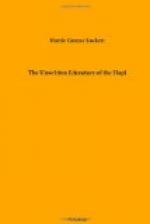A notably fine example of such encouragement is the work of Mary Russell F. Colton of Flagstaff, Arizona, in the Hopi Craftsman Exhibition held annually at the Northern Arizona Museum of which she is art curator. At the 1931 Exhibition, 142 native Hopi sent in 390 objects. Over $1500 worth of material was sold and $200 awarded in prizes. The attendance total of visitors was 1,642. From this exhibit a representative collection of Hopi Art was assembled for the Exposition of Indian Tribal Arts at the Grand Central Galleries, New York City, in December of the same year. A gratifying feature of these annual exhibits is the fact that groups of Hopi come in from their reservation 100 miles away and modestly but happily move about examining and enjoying these lovely samples of their own best work and that of their neighbors; and they are quick to observe that it is the really excellent work that gets the blue ribbon, the cash prize, and the best sale.
Dr. Fewkes points out that while men invented and passed on the mythology of the tribe, women wrote it down in symbols on their handicrafts which became the traditional heritage of all.
The sand paintings made for special ceremonies on the floors of the various kivas, in front of the altars, are likewise designs carried only in the memory of the officiating priest and derived from the clan traditions. All masks and ceremonial costumes are strictly prescribed by tradition. The corn symbol is used on everything. Corn has always been the bread of life to the Hopi, but it has been more than food, it has been bound up by symbolism with his ideas of all fertility and beneficence. Hopi myths and rituals recognize the dependence of their whole culture on corn. They speak of corn as their mother. The chief of a religious fraternity cherishes as his symbol of high authority an ear of corn in appropriate wrappings said to have belonged to the society when it emerged from the underworld. The baby, when twenty days old, is dedicated to the sun and has an ear of corn tied to its breast.
V. HOUSE BUILDING
* * * * *
As already stated, the house (See Figure 3) belongs to the woman. She literally builds it, and she is the head of the family, but the men help with the lifting of timbers, and now-a-days often lay up the masonry if desired; the woman is still the plasterer. The ancestral home is very dear to the Hopi heart, men, women, and children alike.
After the stone for building has been gathered, the builder goes to the chief of the village who gives him four small eagle feathers to which are tied short cotton strings. These, sprinkled with sacred meal, are placed under the four corner stones of the new house. The Hopi call these feathers Nakiva Kwoci, meaning a breath prayer, and the ceremony is addressed to Masauwu. Next, the door is located by placing a bowl of food on each side of where it is to be.




